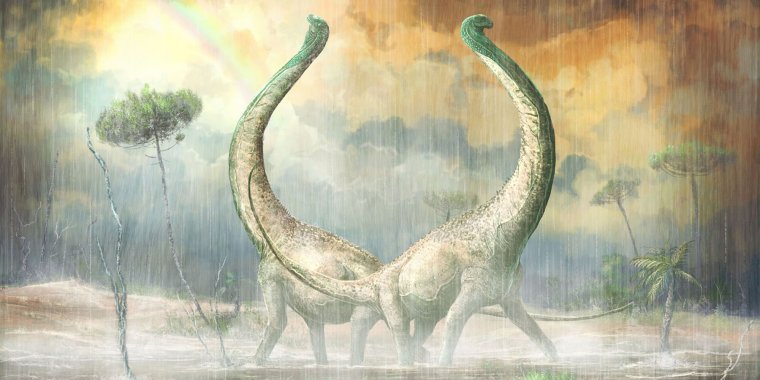| News / Science News |
New dinosaur with heart-shaped tail offers clues to evolution of Africa's ecosystems
A dinosaur that wore its "heart" on its tail is providing new clues to how ecosystems evolved on the African continent during the Cretaceous Period some 100 million years ago, according to researchers at Ohio University.

Reconstruction of a pair of M. moyowamkia in a rainstorm in Tanzania during the Cretaceous Period. Credit: Mark Witton
The dinosaur, the third found in southwestern Tanzania by the scientists, is a large, long-necked titanosaur, a type of sauropod.
Its partial skeleton was recovered from Cretaceous Period rocks exposed in a cliff surface in the western branch of the East African Rift System.
The dinosaur is named Mnyamawamtuka moyowamkia. Its name is derived from the Swahili term for "animal of the Mtuka (with) a heart-shaped tail," in reference to the riverbed (Mtuka) in which it was discovered and the unique shape of its tail bones.
This new dinosaur gives us important information about African fauna during a time of evolutionary change. The finding offers insights into paleogeography during the Cretaceous.
The initial discovery of M. moyowamkia happened in 2004, when part of the skeleton was discovered high in a cliff wall overlooking the seasonally dry Mtuka riverbed, with excavations continuing through 2008.
Although titanosaurs became one of the most successful dinosaur groups before the mass extinction capping the Age of Dinosaurs, their early evolutionary history remains obscure, and Mnyamawamtuka helps reveal those beginnings.
The wealth of information from the skeleton indicates that it was distantly related to other known African titanosaurs, except for some interesting similarities with another dinosaur, Malawisaurus, from just across the Tanzania-Malawi border.
Titanosaurs are best known from Cretaceous rocks in South America, but efforts by the team include new titanosaur species discovered in Tanzania, Egypt and other parts of the African continent. They reveal a complex picture of dinosaur evolution.
The excavation process spanned several years, and included researchers suspended by ropes and large-scale mechanical excavators to recover one of the more complete specimens from this part of the sauropod dinosaur family tree.
M. moyowamkia and other Tanzanian titanosaurs are not the only animals discovered by the research team. Remains of bizarre relatives of early crocodiles, the oldest evidence for "insect farming," and tantalizing clues about the early evolution of monkeys and apes have been found.
These discoveries from the East African Rift System, the scientists say, provide a glimpse into the ancient ecosystems of Africa, and provide the impetus for future work elsewhere on the continent. (National Science Foundation)
YOU MAY ALSO LIKE





